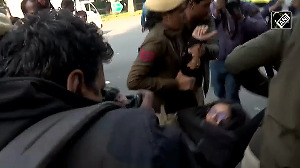At that time, the GSM cellular industry had pooh poohed this contention, arguing incorrectly that their licence entitled them to as much spectrum as they needed. They contended that, as their subscriber base increased, their licence and subsequent government notifications said the government was obligated to provide them free additional spectrum.
Against that backdrop, the latest letter from Bharti Airtel to the telecom secretary, offering to pay Rs 2,650 crore (Rs 26.50 billion) for 4.4 MHz of spectrum, is an important break in the GSM industry's stand.
On the face of it, Airtel's offer is restricted to Rs 1,000 crore (Rs 10 billion) more than what the government is charging Reliance for similar spectrum, but in fact the ground conceded is much more.
Indeed, how the Rs 1,000 crore was arrived at is interesting. The Rs 1,651 crore (rs 1650 billion) that Reliance is paying is the auction price arrived at in 2001, when the fourth cellular licence was auctioned - so while Reliance Communications is being charged a price discovered six years ago, Airtel has calculated the present value of the 2001 price by adding on an interest charge, to arrive at its new offer.
But even more interestingly, the country's leading mobile phone firm has said that, if the government decides to auction the spectrum, this Rs 2,650 crore offer should be treated as its initial bid in the auction.
In other words, the GSM section of the industry has moved all the way from wanting free spectrum to acceptance of open auction, which is a remarkable amount of ground to cover in response to the gate-crashing done by Reliance. But while Mr Ambani has now got the GSM industry to admit to the largesse it got in the past, it is important to carry the process of price discovery to its logical conclusion.
Going by his own letter, Mr Ambani is getting spectrum worth anything up to Rs 7,000 crore (Rs 70 billion) for a mere Rs 1,651 crore. Surely he should not expect to retain the kind of gift that, when others got, he protested about.
It is important to keep in mind that, in 2001, the industry was hardly developed and had just 4-5 million subscribers, a figure which is achieved in less than a month in today's hot market. What auctioning of spectrum will ensure is that the benefits of low-cost spectrum will not accrue to the mobile phone firms alone, and will come in part to the exchequer.
The tricky question is how to impose an auctioning system on what is existing reality, which is the spectrum that has already been given out on sub-market terms.
Ideally, the GSM cellular industry must be asked to pay for the extra spectrum it has got beyond the licensed 6.2 MHz. While the telecom ministry is in favour of taking back the extra spectrum, this is certain to lead to prolonged litigation.
The best solution is to ask the GSM industry to pay for the extra spectrum, based on the price discovered while auctioning spectrum now. And if the industry is told it cannot bid for fresh spectrum until it pays this amount, there is little question of it refusing.
This will clean up the current spectrum mess, where both the GSM and the CDMA mobile phone players accuse the government of favouring the other by adopting liberal subscriber-linked spectrum allocation norms.
PM wants fair policy for spectrum allocation







 © 2025
© 2025